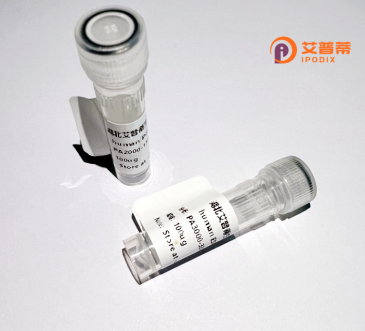
| 纯度 | >90%SDS-PAGE. |
| 种属 | Human |
| 靶点 | TRIP4 |
| Uniprot No | Q15650 |
| 内毒素 | < 0.01EU/μg |
| 表达宿主 | E.coli |
| 表达区间 | 2-581 aa |
| 活性数据 | AVAGAVSGE PLVHWCTQQL RKTFGLDVSE EIIQYVLSIE SAEEIREYVT DLLQGNEGKK GQFIEELITK WQKNDQELIS DPLQQCFKKD EILDGQKSGD HLKRGRKKGR NRQEVPAFTE PDTTAEVKTP FDLAKAQENS NSVKKKTKFV NLYTREGQDR LAVLLPGRHP CDCLGQKHKL INNCLICGRI VCEQEGSGPC LFCGTLVCTH EEQDILQRDS NKSQKLLKKL MSGVENSGKV DISTKDLLPH QELRIKSGLE KAIKHKDKLL EFDRTSIRRT QVIDDESDYF ASDSNQWLSK LERETLQKRE EELRELRHAS RLSKKVTIDF AGRKILEEEN SLAEYHSRLD ETIQAIANGT LNQPLTKLDR SSEEPLGVLV NPNMYQSPPQ WVDHTGAASQ KKAFRSSGFG LEFNSFQHQL RIQDQEFQEG FDGGWCLSVH QPWASLLVRG IKRVEGRSWY TPHRGRLWIA ATAKKPSPQE VSELQATYRL LRGKDVEFPN DYPSGCLLGC VDLIDCLSQK QFKEQFPDIS QESDSPFVFI CKNPQEMVVK FPIKGNPKIW KLDSKIHQGA KKGLMKQNKA V |
| 分子量 | 66.1 kDa |
| 蛋白标签 | His tag N-Terminus |
| 缓冲液 | PBS, pH7.4, containing 0.01% SKL, 1mM DTT, 5% Trehalose and Proclin300. |
| 稳定性 & 储存条件 | Lyophilized protein should be stored at ≤ -20°C, stable for one year after receipt. Reconstituted protein solution can be stored at 2-8°C for 2-7 days. Aliquots of reconstituted samples are stable at ≤ -20°C for 3 months. |
| 复溶 | Always centrifuge tubes before opening.Do not mix by vortex or pipetting. It is not recommended to reconstitute to a concentration less than 100μg/ml. Dissolve the lyophilized protein in distilled water. Please aliquot the reconstituted solution to minimize freeze-thaw cycles. |
1. **"TRIP4. a novel thyroid hormone receptor-interacting protein that potentiates thyroid hormone action"**
- **作者**: Jung, D.J. et al.
- **摘要**: 研究发现TRIP4通过与甲状腺激素受体(TR)结合,增强甲状腺激素依赖的转录活性,并揭示了其ASCH-YJ结构域在调控核受体信号通路中的关键作用。
2. **"The ASCH/YJ domain protein TRIP4 participates in DNA damage response"**
- **作者**: Wang, C. et al.
- **摘要**: 本文证明TRIP4通过参与ATM/ATR介导的DNA损伤修复通路,在维持基因组稳定性中发挥重要作用,其缺失会导致细胞对电离辐射敏感性增加。
3. **"TRIP4 interacts with RNA polymerase II to integrate transcriptional and coactivator functions"**
- **作者**: Li, Y. et al.
- **摘要**: 揭示了TRIP4通过直接结合RNA聚合酶II,协调转录延伸与染色质重塑复合物(如SWI/SNF)的招募,从而调控基因表达的分子机制。
4. **"Role of TRIP4 in neural development via ALKBH3-mediated RNA modification"**
- **作者**: Zhang, L. et al.
- **摘要**: 发现TRIP4与RNA去甲基化酶ALKBH3互作,通过调控靶基因mRNA的m6A修饰影响神经干细胞分化和大脑皮质发育异常相关的疾病表型。
Thyroid hormone receptor-interacting protein 4 (TRIP4), also known as ASC-1 complex subunit 2 (ASCC2), is a multifunctional protein involved in transcriptional regulation and RNA processing. It was initially identified as a coactivator of nuclear receptors, including thyroid hormone receptors, through its interaction with ligand-binding domains. Structurally, TRIP4 contains an N-terminal activation domain, a central coiled-coil motif, and a C-terminal RNA recognition motif, enabling interactions with transcriptional machinery and RNA molecules.
Functionally, TRIP4 is a core component of the ASC-1 (Activator of Signal transducer and activator of transcription protein and Chromatin remodeling) complex, which participates in DNA damage repair, particularly alkylation damage, via the base excision repair pathway. It also regulates alternative splicing of pre-mRNAs by associating with spliceosome components. Studies link TRIP4 to cellular stress responses, myoblast differentiation, and skeletal muscle maintenance, with its dysregulation implicated in muscular atrophy and cancer progression. For example, TRIP4 overexpression is observed in lung adenocarcinoma and hepatocellular carcinoma, potentially promoting tumorigenesis through transcriptional misregulation. Mutations in TRIP4 are associated with autosomal recessive congenital myopathy and spinal muscular atrophy phenotypes, highlighting its critical role in neuromuscular health. Ongoing research focuses on its dual roles in transcription-coupled repair and RNA metabolism.
×